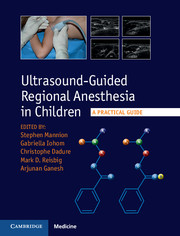Book contents
- Frontmatter
- Contents
- List of contributors
- 1 Introduction
- Section 1 Principles and practice
- Section 2 Upper limb
- Section 3 Lower limb
- Section 4 Truncal blocks
- 14 Ultrasound-guided ilioinguinal/iliohypogastric block
- 15 Ultrasound-guided transversus abdominis plane block
- 16 Ultrasound-guided rectus sheath block
- 17 Ultrasound-guided paravertebral block
- Section 5 Neuraxial blocks
- Section 6 Facial blocks
- Appendix: Muscle innervation, origin, insertion, and action
- Index
- References
16 - Ultrasound-guided rectus sheath block
from Section 4 - Truncal blocks
Published online by Cambridge University Press: 05 September 2015
- Frontmatter
- Contents
- List of contributors
- 1 Introduction
- Section 1 Principles and practice
- Section 2 Upper limb
- Section 3 Lower limb
- Section 4 Truncal blocks
- 14 Ultrasound-guided ilioinguinal/iliohypogastric block
- 15 Ultrasound-guided transversus abdominis plane block
- 16 Ultrasound-guided rectus sheath block
- 17 Ultrasound-guided paravertebral block
- Section 5 Neuraxial blocks
- Section 6 Facial blocks
- Appendix: Muscle innervation, origin, insertion, and action
- Index
- References
Summary
Clinical use
The rectus sheath block can be used to provide post-operative analgesia for anterior abdominal procedures (Gurnaney et al., 2011). In 1996 the rectus sheath block was suggested as an option for providing post-operative analgesia for an umbilical hernia repair (Ferguson et al., 1996). Since then this technique has been used to provide analgesia for umbilical and epigastric hernia repair, laparoscopic surgery, and other small midline incisions and has been found to provide better analgesia than wound infiltration (Breschan et al., 2013; Dingeman et al., 2013; Flack et al., 2014). It has also been used for the relief of chronic abdominal wall pain (Skinner and Lauder, 2007). A rectus sheath catheter technique can be used for midline laparotomy procedures for providing post-operative analgesia (Courreges and Poddevin, 1998).
The rectus sheath block anesthetizes the anterior divisions of the seventh, eighth, ninth, tenth, and eleventh thoracic intercostal nerves, which are called the thoracoabdominal nerves. These nerves innervate the anterior abdominal wall. They continue anteriorly from the intercostal space into the abdominal wall. In the abdominal wall the nerves reach the posterior layer of the internal oblique aponeurosis and continue between the transversus abdominis and internal oblique muscles. At the lateral border of the rectus abdominis muscle, the external oblique aponeurosis and the anterior lamella of the internal oblique apo-neurosis form the anterior rectus sheath, while the posterior lamella of the internal oblique aponeurosis and the aponeurosis of the transversus abdominis form the posterior rectus sheath. At the lateral edge of the rectus abdominis muscle each nerve pierces the internal oblique aponeurosis and lies between the rectus abdominis muscle and the posterior rectus sheath. These nerves supply the rectus abdominis and end as the anterior cutaneous branch of the abdomen. The ninth thoracic nerve supplies the skin above the umbilicus, the tenth nerve supplies the umbilical region, and the eleventh nerve supplies the skin below the umbilicus.
This region is readily visualized using ultrasound, allowing accurate deposition of local anesthetic (LA) into the rectus sheath itself (Flack et al., 2014). No correlation has been found between the depth of the posterior rectus sheath and the child's weight, height, or body surface area (Willschke et al., 2006).
- Type
- Chapter
- Information
- Ultrasound-Guided Regional Anesthesia in ChildrenA Practical Guide, pp. 112 - 116Publisher: Cambridge University PressPrint publication year: 2015



